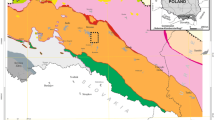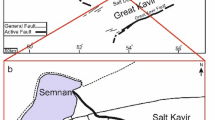Abstract
The paper reports the role of hydrocarbon microseepage in surface alterations of trace metal concentrations. In this study trace metal alterations were mapped that appear to be associated with hydrocarbon microseepages in the oil/gas fields of Mehsana block, North Cambay basin, India. The ranges of adsorbed soil gas concentrations of Methane, Ethane, Propane, i-Butane and n-Butane are found to vary from 1–402 ppb, 1–135 ppb, 1–70 ppb, 1–9 ppb, 1–18 ppb respectively, suggesting the presence of hydrocarbons and microseepage associated with the study area. The carbon isotopic signature of methane ranged from −29.5 to −43.0‰ (PDB) and ethane from −19.1 to −20.9‰ (PDB), indicating a thermogenic source of hydrocarbons. The absence of any significant correlation of Total Organic Carbon (TOC) and Total Inorganic Carbon (TIC) (r = 0.1 and 0.5 respectively) content with hydrocarbons in soil samples demonstrates the catagenetic origin of the desorbed gases. The Trace metal concentrations varied in the following manner: Ni: 49–155 ppm, V: 67–158 ppm, Cu: 29–82 ppm, Zn: 64–327 ppm, Ba: 241–554 ppm and Sr: 118–892 ppm. These high concentrations of trace metals which are more than their respective average concentrations generally found in soils are indicative of hydrocarbon induced alterations in the area. The low Eh values observed in anomalous hydrocarbon bearing soil samples compared to non anomalous samples in the area, could be attributed to the reducing conditions created by the hydrocarbon seepage from subsurface and might have influenced the trace metal solubilities which is reflected in their increased concentrations. Trace metal anomalies are seen haloed to adsorbed soil gas anomalies (ΣC2+) indicating that the major generative depressions of oil and /or gas fields of Sobhasan / Linch in the study area promoted vertical migration of hydrocarbon microbubbles which in turn facilitated trace metal deposition in the surface soils. By using integrated method approach, the weak signal of oil and gas reservoirs could be amplified in the frontier areas and the uncertainity of the vertical correlation of surface anomalies could be reduced.
Similar content being viewed by others
References
Al-Shahristani, H. and Al-Atyia, M.J., 1972, Vertical migration of oil in Iraqi oil fields: Evidence based on vanadium and nickel concentrations. Geochimica et Cosmochimica Acta, 36, 929–938.
Banerjee, A. and Rao, K.L.N., 1993, Geochemical evaluation of part of the Cambay Basin, India. American Association of Petroleum Geologists Bulletin, 77, 29–48.
Banerjee, A., Jha, M., Mittal, A.K, Thomas, N.J., and Misra, K.N, 2000, The effective source rocks in the Cambay Basin, India. Marine and Petroeum Geology, 17, 1111–1129.
Bhandari, L.L and Choudhary, L.R., 1975, Stratigraphic Analysis of Kadi and Kalol Formations, Cambay Basin, India. American Association of Petroleum Geologists Bulletin, 59, 856–871.
Bowen, H.J.M., 1966, Trace Elements in Biochemistry. Academic Press, London, 241 p.
Calmano, W., Hong, J., and Forstner, U., 1993, Binding and mobilization of heavy metals in contaminated sediments affected by pH and redox potential. Water Science and Technology, 28, 223–235.
Charlatchka, R. and Cambier, P., 2000, Influence of reducing conditions on solubility of trace metals in contaminated soils. Water, air and soil pollution, 118, 143–167.
Chowdhary, L.R., 2004, Petroleum Geology of the Cambay Basin Gujarat, India. Indian Petroleum Publishers, Dehradun, 171 p.
Chuan, M.C., Shu, G.Y., and Liu, J.C., 1996, Solubility of heavy metals in a contaminated soil: Effects of redox potential and pH. Water, air and soil pollution, 90, 543–556.
Clark, J.R., 1997, Concepts and models for interpretation of Enzyme LeachSM data for mineral and petroleum exploration. In: Enzyme LeachSM Models, Sampling Protocol & Case Histories. Activation Laboratories Ltd., Ancaster, Ontario, p. 1–62.
Clark, J.R., Reno, N.V., and Tompkins, R., 2003, Mapping of Reservoirs and Subsurface Structures Using Selective Analysis of the Surface Chemistry of Soil Particles. 88th Annual Meeting of AAPG (Extended Abstract), Salt Lake City, May 11–14.
Donovan, T.J., 1974, Petroleum microseepage at Cement, Oklahomaevidence and mechanisms. American Association of Petroleum Geologists Bulletin, 58, 429–446.
Duchscherer, Jr., W., 1983, Geochemical hydrocarbon exploration — a new/old exploration tool. In: Proceedings of the 9th International Geochemical Exploration Symposium, Journal of Geochemical Exploration, 19, 335–336.
Gast, R.G., 1979, In: Fairbridge, R.W. and Finkl Dowden, C.W. (eds.), Encyclopedia of Soil Science Hutchinson & Ross, Stroudsburg Pa., 148–152.
Jones, V.T. and Drodz, R.J., 1983, Predictions of Oil or Gas Potential By Near Surface Geochemistry. American Association of Petroleum Geologists Bulletin, 67, 932–952.
Kabata-Pendias, A., 1993, Behavioural properties of trace metals in soils. Applied Geochemistry, Supplement 2, 8, 3–9.
Kalpana, M.S., Patil, D.J., Dayal, A.M., and Raju, S.V., 2010a, Near Surface Manifestation of Hydrocarbons in Proterozoic Bhima and Kaladgi Basins: Implications to Hydrocarbon Resource Potential. Journal Geological Society of India, 76, 548–556.
Kalpana, G., Madhavi, T., Patil, D.J., Dayal, A.M., and Raju, S.V., 2010b, Light gaseous hydrocarbon anomalies in the near surface soils of Proterozoic Cuddapah Basin: Implications for hydrocarbon prospects. Journal of Petroleum Science and Engineering, 73, 161–170.
Klusman, R.W., 1993, Soil Gas and Related Methods for Natural Resource Exploration. John Wiley & Sons, Chichester, 483 p.
Larriestra, F., Ferrer, F., Larriestra, C., and Lanussol, D., 2010, Geochemical Anomalies Characterization by Microbial and Trace Element Analysis related to hydrocarbon migration, Nequen Basin, Argentina. Search and Discovery (AAPG Datapages), #40667.
Madhavi, T., Kumar, S.T., Rasheed, M.A., Kalpana, G., Patil, D.J., and Dayal, A.M., 2009, Light Hydrocarbons Geochemistry of Surface Sediment from Petroliferous Region of the Mehsana Block, North Cambay Basin. Journal Geological Society of India, 74, 7–15.
Maier, R.M., Pepper, I.L., and Gerba, C.P, 2009, Environmental Microbiology, 2nd Edition, Academic Press, 624 p.
Mathur, L.P., Rao, K.L.N., and Chaube, A.N., 1968, Tectonic framework of Cambay Basin, India. ONGC Bulletin, 5, 7–28.
Oehler, D.Z. and Sternberg, B.K., 1984, Seepage-induced anomalies, “false” anomalies, and implications for electrical prospecting. American Association of Petroleum Geologists Bulletin, 68, 1121–1145.
Pandey, A.N., Upadhyay, H., and Minz, P.K., 1993, Lithofacies, Depositional environments and Reservoir Characteristic of Middle Eocene Sands in Nada Area, Cambay Basin. In: Biswas, S.K., Alok Dave, Garg, P., Jagadish Pandey, Maithani, A. and Thomas, N.J, (eds.), Proceedings of 2nd Seminar on Petroliferous Basins of India, Indian Petroleum Publishers, Dehradun, 2, 121–135.
Petrovic, A., Khan, S.D., and Chafetz, H.S., 2008, Remote detection and geochemical studies for finding hydrocarbon-induced alterations in Lisbon Valley, Utah. Marine and Petroleum Geology, 25, 696–705.
Pirson, S. J., 1969, Geological, geophysical, and geochemical modification of sediments in the environments of oil fields. In: Heroy, W.B., (ed.), Unconventional methods in exploration for petroleum and natural gas, symposium 1. Southern Methodist University Press, Dallas, 159–186.
Prasanna, M.V., Rasheed, M.A., Madhavi, T., Kalpana, G., Patil, D.J., and Dayal, A.M., 2010, Light gaseous hydrocarbon anomalies in the near-surface soils of Sagar District, Vindhyan Basin, India. Current Science, 99, 1586–1590.
Price, L.C., 1986, A critical overview and proposed working model of surface geochemical exploration. In: Davidson, M.J, (ed.), Unconventional methods in exploration for petroleum and natural gas, Symposium IV. Southern Methodist University Press, Dallas, 245–304.
Rennert, T. and Mansfeldt, T., 2006, Release of trace metals, sulfate and complexed cyanide from soils contaminated with gas-purifier wastes: A microcosm study. Environmental Pollution, 139, 86–94
Robinson, B., Bolan, N., Mahimairaja, S., and Clothier, B., 2005, Solubility, mobility, and bioaccumulation of trace elements: Abiotic processes in the rhizosphere. In: Prasad, M.N.V., Sajwan, K.S., and Naidu, R., (eds.), Trace elements in the environment: Biogeochemistry, Biotechnology and Bioremediation. CRC press, Boca Raton, p. 97–110.
Schumacher, D., 1996, Hydrocarbon-induced alteration of soils and sediments. In: Schumacher, D. and Abrams, M.A., (eds.), Hydrocarbon migration and its near-surface expression. American Association of Petroleum Geologists Memoir 66, 71–89.
Schumacher, D. and LeSchack, L.A., 2002, Surface Exploration Case Histories: Applications of Geochemistry, Magnetics and Remote Sensing. AAPG Studies in Geology. No.48, SEG Geophysical References Series 11, p. 486.
Schumacher, D., 2003, Geochemical Exploration for Oil and Gas-Strategies for Success. An Exploration Short Course sponsored by National Geophysical Research Institute, Hyderabad, India, December 8, p. 1–175.
Taylor, S.R., 1964, Abundance of chemical elements in the continental crust: a new table. Geochimica et Cosmochimica Acta, 28, 1273–1285.
Tedesco, S.A., 1995, Surface Geochemistry in Petroleum Exploration. Chapman and Hall, International Thompson Publishing Inc., 122 p.
Vinogradov, A.P., 1959, Geochemistry of Rare and Dispersed Chemical Elements in Soils. Consultants Bureau, New York, 209 p. (translation from Russian).
Author information
Authors and Affiliations
Corresponding author
Rights and permissions
About this article
Cite this article
Madhavi, T., Kalpana, M.S., Patil, D.J. et al. Evidence for a relationship between hydrocarbon microseepage and trace metal anomalies: an implication for petroleum exploration. Geosci J 15, 197–206 (2011). https://doi.org/10.1007/s12303-011-0015-y
Received:
Accepted:
Published:
Issue Date:
DOI: https://doi.org/10.1007/s12303-011-0015-y




